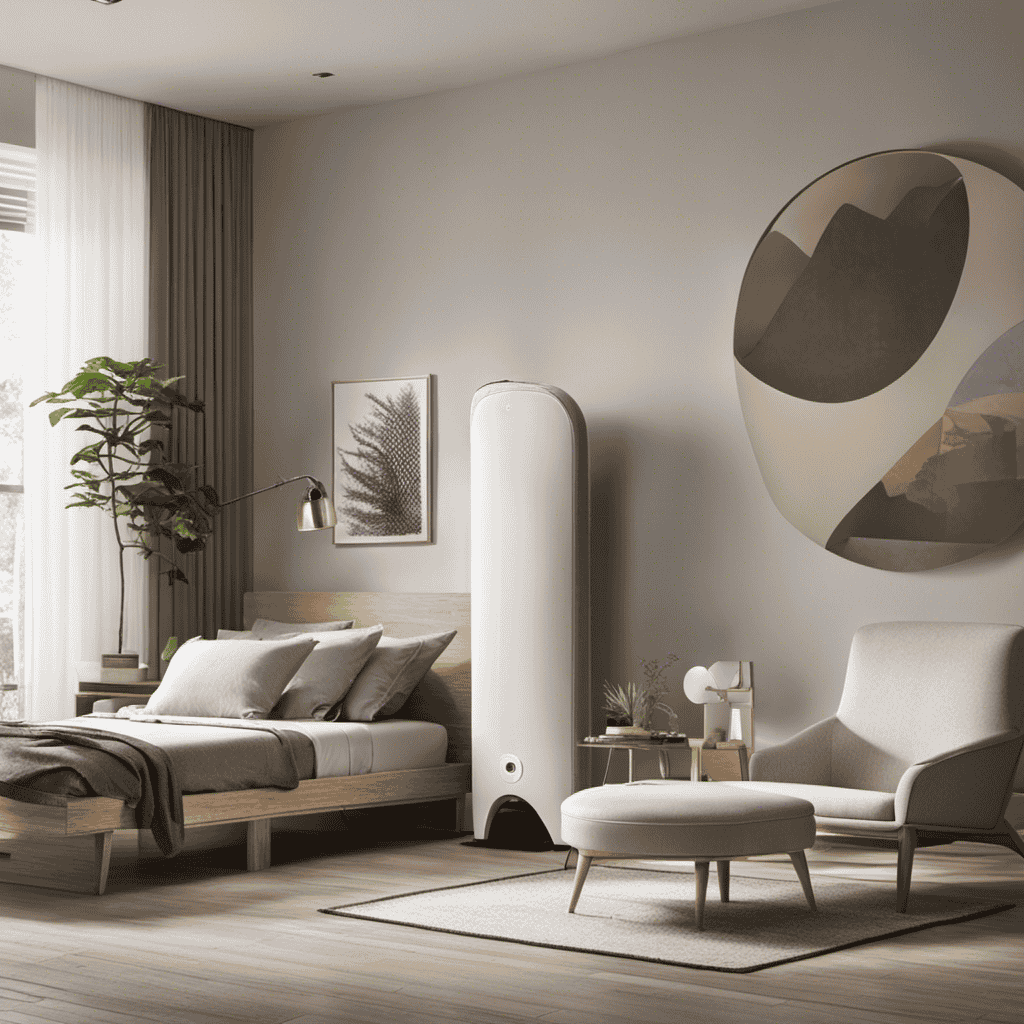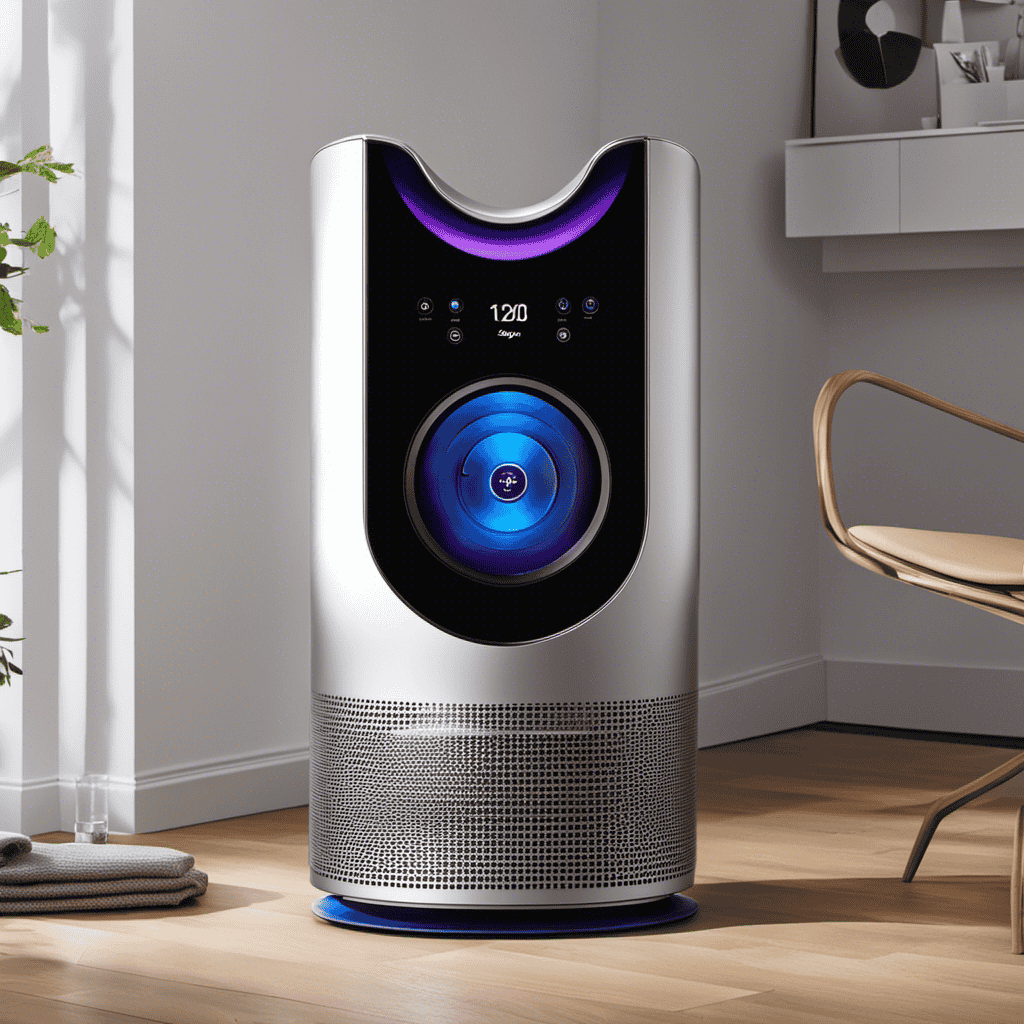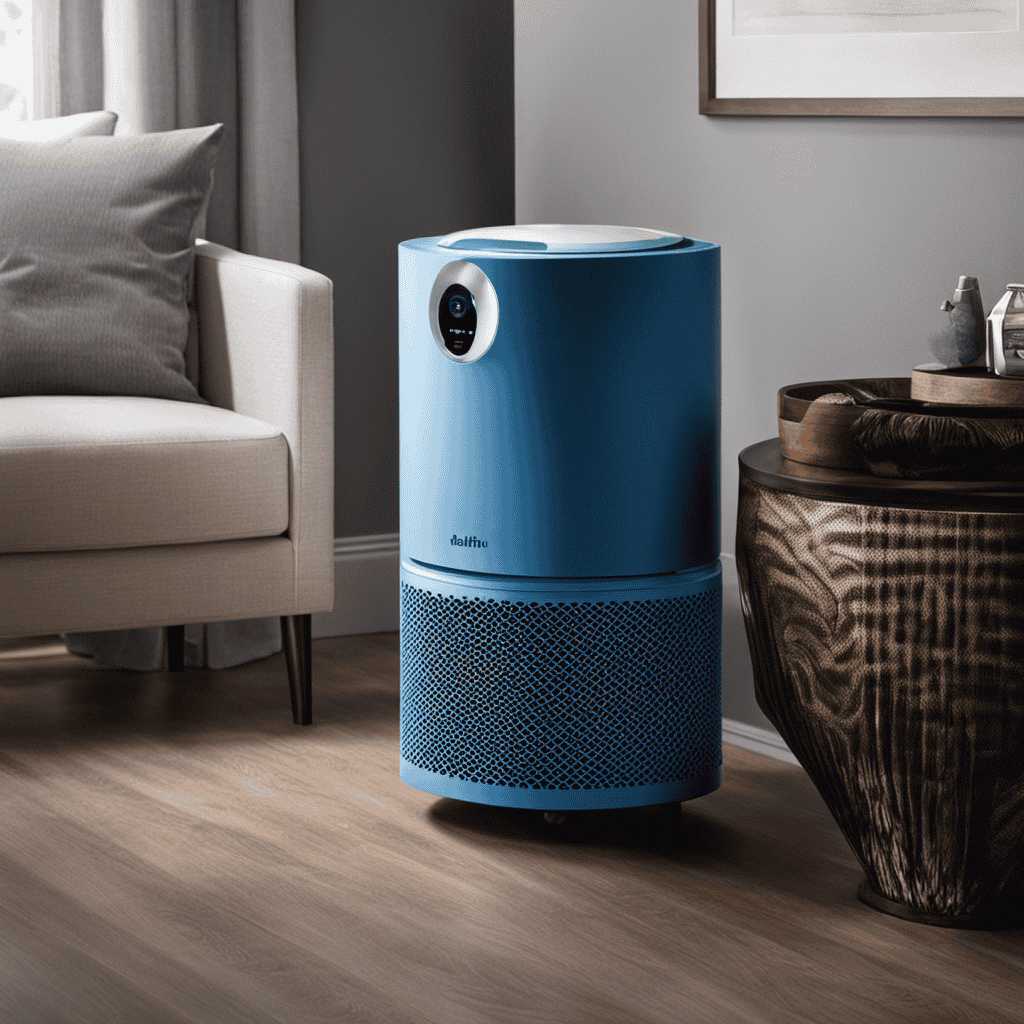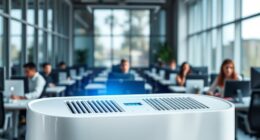I’ve always been familiar with the phrase “more is better.” However, when it comes to operating my air purifier, how much time is sufficient? By comprehending the fundamentals of air purifier runtime and taking into account factors like room size and specific requirements, we can establish the ideal runtime for various areas.
Whether you’re battling dust, pet dander, or smoke, finding the optimal runtime is crucial for effective air purification. In this article, we’ll explore the ideal runtime for various scenarios and provide tips to maximize your air purifier’s performance.
Key Takeaways
- Runtime of an air purifier depends on factors such as room size, level of pollution, and type of filter.
- Recommended runtime for small spaces is 8-10 hours per day, for medium spaces is 8-12 hours per day, and for large spaces is 10-14 hours per day.
- Ideal runtime for air purifiers in bedrooms is 8-12 hours per day, while for living rooms it is 4-6 hours per day and for offices it is a few hours per day.
- Regular maintenance, proper air circulation, and choosing the right purifier are important for maximizing effectiveness and energy efficiency.
Understanding the Basics of Air Purifier Runtime
Understanding the basics of air purifier runtime can help you determine how long your unit should run. Air purifiers are designed to improve indoor air quality by removing pollutants such as dust, pollen, and pet dander.
The runtime of an air purifier depends on various factors, including the size of the room, the level of pollution, and the type of filter used.
Regular air purifier maintenance is essential to ensure optimal performance and longevity. This includes cleaning or replacing the filters regularly, as dirty filters can reduce airflow and decrease the efficiency of the unit.
The benefits of air purifiers are numerous, including reducing allergy symptoms, improving respiratory health, and creating a cleaner and more comfortable living environment.
Factors to Consider When Determining Air Purifier Runtime
When determining the runtime of an air purifier, there are several important factors to consider.
First, the size and layout of the room play a crucial role in determining how long the air purifier should run. A larger room may require a longer runtime to effectively clean the air.
Additionally, the air quality levels in the room should be taken into account. If the air quality is poor, the air purifier may need to run for a longer period of time to achieve the desired results.
Lastly, specific purifier features, such as the type of filter used or the presence of additional purification technologies, can also impact the recommended runtime.
Room Size and Layout
To effectively clean the air in your room, it’s important to consider the size and layout. The room size determines the capacity and power of the air purifier required, while the layout affects the airflow and coverage.
Here are some key factors to consider:
-
Room Size: Measure the square footage of your room to determine the appropriate air purifier size. A larger room may require a higher CADR (Clean Air Delivery Rate) to effectively clean the air.
-
Room Temperature: Keep the room temperature moderate as extreme temperatures can affect the air purifier’s performance and lifespan.
-
Air Circulation: Ensure proper air circulation in the room by keeping doors and windows closed, and optimizing the placement of the air purifier. This allows for better air intake and distribution throughout the room.
Considering these factors will help you choose the right air purifier for your room and maximize its effectiveness in providing clean and fresh air.
Air Quality Levels
Maintaining moderate room temperatures is crucial for optimal performance and lifespan of the air purifier.
In addition to temperature, monitoring air quality levels is essential for effective air purifier maintenance. By regularly checking the air quality in your space, you can determine when the air purifier needs to be run and for how long.
High levels of pollutants or allergens may require the air purifier to run for longer periods of time, while lower levels may necessitate shorter run times. Air quality monitoring devices, such as sensors or monitors, can provide real-time data to help you make informed decisions about when to run your air purifier.
By using these tools, you can ensure that your air purifier is running efficiently and effectively to maintain clean and healthy air in your environment.
Transitioning into the subsequent section about specific purifier features, let’s explore how certain features can enhance the air purifier’s performance.
Specific Purifier Features
Enhance the performance of your air purifier with specific features that can optimize its effectiveness. Here are three key features to consider:
-
HEPA Filter: A high-efficiency particulate air (HEPA) filter is essential for capturing tiny particles, such as allergens, dust, and pet dander, improving the overall air quality in your home.
-
Activated Carbon Filter: This filter is designed to remove odors, smoke, and volatile organic compounds (VOCs) from the air, making it a great addition for those with sensitivities or living in urban areas with high pollution levels.
-
Quiet Operation: Noise levels can be a concern, especially if you plan to use your air purifier in a bedroom or office. Look for models that offer a quiet mode or have noise reduction technology to ensure a peaceful environment.
Regular air purifier maintenance, including cleaning or replacing filters, is also crucial for optimal performance and longevity. By investing in these specific features and following proper maintenance practices, you can enjoy cleaner, healthier air while minimizing purifier noise levels.
Recommended Runtime for Air Purifiers in Small Spaces
You should consider running your air purifier for at least 8-10 hours a day in small spaces for optimal air quality. The recommended runtime takes into account the efficiency of air purifiers in removing contaminants from the air.
Research has shown that running an air purifier for a longer duration helps to continually filter the air and maintain a higher level of air quality. Air purifiers work by capturing particles and pollutants through filters or other mechanisms, and the longer they run, the more effective they are at reducing these contaminants.
Additionally, running the air purifier for a longer period allows for better circulation of the purified air throughout the space, ensuring that all areas are adequately cleaned. Therefore, it is important to consider the recommended runtime of 8-10 hours to maximize the benefits of your air purifier and maintain a healthier indoor environment.
Recommended Runtime for Air Purifiers in Medium Spaces
Running an air purifier for a longer period of time in medium spaces helps to effectively filter the air and improve overall air quality. The ideal runtime for an air purifier in medium spaces is around 8 to 12 hours per day.
Here are some reasons why it is beneficial to run your air purifier for a longer duration:
- Remove airborne pollutants such as dust, pollen, and pet dander.
- Reduce the presence of allergens that can trigger respiratory issues.
- Eliminate odors caused by cooking, smoking, or pets.
When considering the ideal runtime for your air purifier, it is important to also consider energy efficiency. Look for purifiers with energy-saving features, such as a timer or an automatic shut-off function. This will help you save energy and reduce electricity costs while still maintaining clean and fresh indoor air.
Recommended Runtime for Air Purifiers in Large Spaces
To effectively filter the air in large spaces, it’s recommended to run an air purifier for at least 10 to 14 hours per day. Continuous operation of an air purifier in large spaces offers several benefits, including improved air quality, reduced allergens and pollutants, and enhanced overall health and well-being. By running the air purifier for an extended period, it allows for consistent removal of airborne particles, such as dust, pollen, pet dander, and mold spores. This helps to create a cleaner and healthier environment for occupants. Additionally, continuous operation ensures that the air is constantly being filtered, minimizing the buildup of pollutants. It is important to note that regular maintenance, such as cleaning or replacing filters, is essential to maintain the effectiveness of the air purifier. Refer to the table below for the recommended maintenance schedule:
| Maintenance Task | Frequency |
|---|---|
| Clean or replace filters | Every 3-6 months |
| Clean the exterior of the purifier | Monthly |
| Check and clean the fan blades | Every 6-12 months |
| Inspect and clean the air vents | Every 3-6 months |
Ideal Runtime for Air Purifiers in Bedrooms
When it comes to determining the optimal duration for running air purifiers, there are several factors to consider.
Firstly, the size of the room plays a crucial role in determining the runtime. Larger spaces may require longer durations to effectively clean the air.
Secondly, balancing energy consumption is important to ensure efficient operation. By finding the right balance between runtime and energy usage, we can effectively purify the air while minimizing energy consumption.
Optimal Air Purifier Duration
The ideal amount of time for an air purifier to operate is typically around 8-12 hours per day. This duration ensures that the air in a room is effectively filtered, providing maximum health benefits.
Here are some discussion ideas to consider when deciding on the optimal air purifier duration:
-
Health benefits:
-
Reduces allergens: Running an air purifier for the recommended time can help remove common allergens like pollen, dust mites, and pet dander from the air, providing relief for allergy sufferers.
-
Eliminates odors: Continuous operation helps eliminate unpleasant odors caused by cooking, pets, or smoke, improving the overall indoor air quality.
-
Minimizes respiratory issues: By filtering out airborne pollutants, an air purifier can reduce the risk of respiratory conditions such as asthma and bronchitis.
-
Noise levels:
-
Consider running the air purifier during the day or evening when noise levels are generally lower.
-
Place the air purifier in a location away from the sleeping area to minimize any potential disturbance while sleeping.
-
Choose an air purifier with a low noise level rating for quieter operation.
Balancing Energy Consumption
To balance energy consumption, you can adjust the fan speed on your air purifier. By selecting a lower fan speed, you can achieve energy efficient operation while still effectively purifying the air in your space. This is because the fan speed directly affects the power consumption of the air purifier.
When the fan speed is set to a higher level, more energy is required to move air through the purifier, resulting in increased power consumption. On the other hand, when the fan speed is reduced, the power consumption decreases, minimizing power usage and ensuring energy efficiency.
It is important to find the right balance between fan speed and air purification effectiveness, as running the air purifier at too low of a fan speed may compromise its ability to effectively remove pollutants from the air.
Ideal Runtime for Air Purifiers in Living Rooms
You’ll want your air purifier to run for about 4-6 hours a day in your living room to maintain optimal air quality. This recommended runtime ensures that the air in your living space is constantly filtered, removing pollutants such as dust, pet dander, and allergens.
However, there are benefits to running your air purifier for longer periods of time:
-
Improved respiratory health: Longer runtime allows for more thorough air purification, reducing the presence of airborne particles that can trigger respiratory issues.
-
Allergen control: By running the air purifier for extended periods, you can effectively control and reduce allergens in the indoor environment, providing relief to allergy sufferers.
-
Odor elimination: Longer runtime helps eliminate unpleasant odors by continuously circulating and filtering the air, leaving your living room smelling fresh and clean.
Remember to adjust the runtime based on the size of your living room and the air quality levels in your area.
Ideal Runtime for Air Purifiers in Offices
For optimal air quality in offices, it’s best to have your air purifier running for a few hours each day. Air purifiers help remove pollutants, allergens, and odors from the air, creating a healthier and more comfortable working environment. The recommended runtime for air purifiers in offices depends on various factors such as the size of the office, the number of occupants, and the level of pollutants present. However, running the air purifier for at least 4-6 hours a day can provide significant benefits.
Here is a table summarizing the benefits of running air purifiers in offices:
| Benefits of Running Air Purifiers in Offices |
|---|
| 1. Improved air quality |
| 2. Reduction in allergens and pollutants |
| 3. Decreased risk of respiratory issues |
Running air purifiers in offices can improve air quality by eliminating harmful particles like dust, pollen, and mold spores. This can lead to a reduction in allergy symptoms and respiratory issues among employees. Additionally, air purifiers help remove volatile organic compounds (VOCs) and odors, creating a more pleasant and productive work environment. Remember to clean or replace the filters regularly for optimal performance.
How Long Should Air Purifiers Run for Allergies
Running an air purifier for a few hours each day can help alleviate allergy symptoms by removing allergens from the air. However, the recommended air purifier runtime for seasonal allergies may vary depending on the severity of symptoms and the type of allergens present. Here are some key points to consider:
-
Pollen allergies: It is recommended to run the air purifier for longer periods, such as 8-12 hours a day, especially during peak pollen seasons. This helps capture pollen particles and reduce their concentration in the air.
-
Indoor allergens: For indoor allergens like dust mites or pet dander, running the air purifier for 4-6 hours each day is generally sufficient to maintain clean air quality.
-
Personal preferences: Some individuals may find relief by running the air purifier continuously throughout the day and night. However, it is essential to follow the manufacturer’s instructions and choose a suitable runtime to avoid overworking the device.
How Long Should Air Purifiers Run for Asthma
To effectively manage my asthma symptoms, I know that running my air purifier for extended periods of time each day is crucial. Air purifiers help remove allergens and irritants from the air, creating a cleaner and healthier environment for me to breathe in.
When it comes to air purifier maintenance, it’s important to follow the manufacturer’s guidelines for filter replacement and cleaning. Regularly cleaning or replacing the filters ensures that the air purifier continues to work efficiently and effectively.
As for recommended air purifier brands, I have found that brands like Honeywell, Coway, and Blueair are highly rated for their performance and durability. Investing in a reliable air purifier can make a significant difference in managing my asthma symptoms and improving my overall respiratory health.
How Long Should Air Purifiers Run for Odor Control
When using an air purifier for controlling odors, it’s important to consider the recommended duration of operation. Maximizing air purifier efficiency is crucial in effectively eliminating odors and improving indoor air quality.
Here are a few benefits of continuous air purifier operation:
-
Consistent odor control: Continuous operation ensures that the air purifier is constantly filtering and removing odor-causing particles from the air, leaving your space smelling fresh and clean.
-
Improved air quality: By running the air purifier continuously, you can significantly reduce the presence of allergens, pollutants, and other airborne particles that can contribute to odors and respiratory issues.
-
Decreased maintenance needs: Continuous operation helps prevent the buildup of odors, dust, and other particles in the air purifier filters, reducing the frequency of filter replacements and maintenance tasks.
How Long Should Air Purifiers Run for Dust Control
To effectively control dust and improve indoor air quality, you’ll want to consider the recommended duration of operation for your air purifier.
When it comes to dust control, the ideal runtime for air purifiers in nurseries is around 24 hours a day. This is because babies and young children are more susceptible to dust and allergens, and having a continuous filtration system can help reduce their exposure.
For people with respiratory conditions, such as asthma or allergies, it is also recommended to run the air purifier continuously. This ensures that the air is constantly being filtered, removing dust particles and other airborne irritants that can trigger respiratory symptoms.
How Long Should Air Purifiers Run for Pet Dander
Running an air purifier continuously helps reduce pet dander and keeps the indoor environment cleaner and healthier. As a pet owner, I understand the struggle of dealing with pet dander allergies and the constant battle to maintain a clean home.
To effectively combat pet dander, it is crucial to choose the right air purifier and determine the optimal runtime for its operation. Here are three key factors to consider:
-
Air purifier capacity: Look for a purifier with a high Clean Air Delivery Rate (CADR) specifically designed to target pet dander. This ensures efficient removal of allergens from the air.
-
Room size: Consider the square footage of the room where the purifier will be placed. A larger room may require a longer runtime to effectively filter the air.
-
Pet activity levels: If your pets are constantly shedding or spend a lot of time indoors, you may need to run the air purifier for longer periods to maintain clean air quality.
How Long Should Air Purifiers Run for Smoke Removal
If you’re dealing with smoke removal, running an air purifier continuously is essential for maintaining clean and healthy indoor air quality. Smoke particles can be particularly challenging to remove from the air, as they can be small and easily suspended. An air purifier can help capture and filter out these smoke particles, reducing the odor and improving air quality. However, it’s important to note that air purifier effectiveness can vary depending on factors such as the size of the room and the strength of the purifier. Regular maintenance is also crucial to ensure optimal performance. This includes cleaning or replacing filters, checking for any blockages, and keeping the purifier in a well-ventilated area. By following these guidelines, you can maximize the effectiveness of your air purifier and maintain a healthier indoor environment.
| Factor | Recommendation |
|---|---|
| Room Size | Choose an air purifier that is suitable for the size of the room. Refer to the manufacturer’s guidelines for guidance. |
| Purifier Strength | Select an air purifier with a high Clean Air Delivery Rate (CADR) for smoke removal. Look for models with a CADR rating specifically for smoke particles. |
| Maintenance | Regularly clean or replace filters according to the manufacturer’s instructions. Check for any blockages in the purifier and clean them if necessary. Ensure the purifier is placed in a well-ventilated area to maximize its efficiency. |
Tips for Maximizing Air Purifier Runtime
In order to ensure optimal air purification and energy efficiency, it’s important to consider the runtime of your air purifier.
By understanding the recommended duration of operation for your specific model, you can maximize its effectiveness in removing pollutants from your indoor environment.
Additionally, adopting energy-saving practices such as utilizing the timer function or adjusting the fan speed can help conserve energy without compromising the air purification process.
Optimal Air Purifier Runtime
The ideal amount of time for your air purifier to operate is typically determined by the size of your space and the air quality concerns you are trying to address. To maximize efficiency and ensure optimal air purification, it is recommended to follow these schedules:
-
Regular Operation: Run your air purifier continuously for 24 hours a day, especially if you have severe allergies or live in an area with high pollution levels.
-
Nighttime Operation: If you only need air purification while you sleep, consider running the purifier in your bedroom during the night and turning it off during the day.
-
Targeted Operation: For specific areas with air quality issues, such as the kitchen or bathroom, run the air purifier when these spaces are in use or during peak pollution times.
Energy-Saving Air Purifier
Now, let’s explore the benefits of an energy-saving air purifier.
These devices come equipped with various energy-saving features that not only promote environmental sustainability but also ensure cost-effective operation.
One such feature is the programmable timer, allowing you to set specific operating hours to match your needs. This eliminates unnecessary energy consumption during periods when air purification is not required, such as when you’re away from home or asleep.
Additionally, energy-saving air purifiers often have sensors that detect air quality levels in real-time. By adjusting the fan speed automatically based on the air quality, these devices optimize energy usage while maintaining efficient purification.
With these energy-saving features in place, you can enjoy clean, healthy air without worrying about excessive energy consumption or high electricity bills.
What is the ideal running time for an air purifier to effectively clean the air?
The ideal running time for an air purifier to effectively clean the air depends on the size of the room and the level of air pollution. In general, experts recommend running the air purifier for at least 8 hours a day, but it can vary based on individual needs. When considering how long air purifier run, it’s important to follow the manufacturer’s guidelines for maximum effectiveness.
Frequently Asked Questions
How Long Should Air Purifiers Run to Effectively Reduce Allergens in the Air?
I recommend running your air purifier for at least 8 hours a day to effectively reduce allergens in the air. This duration is sufficient to minimize pollen levels and minimize the presence of mold spores.
What Is the Recommended Runtime for Air Purifiers to Alleviate Asthma Symptoms?
The recommended runtime for air purifiers to alleviate asthma symptoms and effectively reduce indoor pollutants varies depending on the size of the room and the air quality. It’s important to follow manufacturer guidelines and consider the specific needs of your space.
How Long Should Air Purifiers Run to Effectively Control Odors in the Air?
I find that the factors affecting the runtime of air purifiers for odor control include the size of the space, the intensity of the odors, and the efficiency of the filters. The role of air purifier filters is crucial in effectively controlling odors in the air.
What Is the Ideal Runtime for Air Purifiers to Minimize Dust Particles in the Air?
Running an air purifier continuously has numerous benefits. It helps minimize dust particles in the air, creating a cleaner and healthier environment. The ideal runtime for air purifiers may vary, but longer durations yield better results.
How Long Should Air Purifiers Run to Efficiently Remove Pet Dander From the Air?
I find that running my air purifier for at least 8 hours a day effectively removes pet dander from the air. However, for more stubborn pollutants like cigarette smoke, it may need to run longer.
Conclusion
In conclusion, after examining the factors and recommendations for air purifier runtime, it is clear that there is no one-size-fits-all answer. The appropriate runtime depends on the size of the space, the specific air quality concern, and individual preferences.
However, it is important to remember that ‘Rome wasn’t built in a day.’ Similarly, air purification is a continuous process that requires consistent and extended runtime to effectively remove pollutants from the air.
Following the recommended guidelines and implementing tips to maximize runtime will ensure optimal air quality and a healthier living environment.










